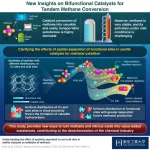(Press-News.org) EMBARGOED FOR RELEASE UNTIL 4 P.M. ET, WEDNESDAY, MAY 15, 2024
MINNEAPOLIS – A new guideline has been issued to help neurologists and other clinicians determine the best antiseizure medications for people with epilepsy who may become pregnant. The guideline is published in the May 15, 2024, online issue of Neurology®, the medical journal of the American Academy of Neurology (AAN), and was developed through a collaboration between the AAN, the American Epilepsy Society (AES) and the Society for Maternal-Fetal Medicine (SMFM). It was endorsed by the Child Neurology Society.
The guideline partially updates two 2009 AAN and AES guidelines on the management of epilepsy during pregnancy, specifically regarding malformations at birth and the development of children born to people with epilepsy.
“Most children born to people with epilepsy are healthy, but there is a small risk of pregnancy-related problems, partly due to seizures and partly due to the effects of antiseizure medications,” said author Alison M. Pack, MD, MPH, of Columbia University in New York City, a Fellow of the American Academy of Neurology and a member of the American Epilepsy Society. “This guideline provides recommendations regarding the effects of antiseizure medications and folic acid supplementation on malformations at birth and the development of children during pregnancy so that doctors and people with epilepsy can determine which treatments may be best for them.”
The guideline recommendations are based on a review of all available evidence on the topic. Risks can include major congenital malformations, or birth defects, fetal growth issues and neurodevelopmental effects such as autism or lower IQ scores.
The guideline states when treating people with epilepsy who may become pregnant, doctors should recommend medications and doses that optimize both seizure control and fetal development at the earliest possible opportunity before pregnancy.
During pregnancy, it recommends minimizing the occurrence of tonic-clonic seizures, seizures with full body spasms, to minimize risks to the parent and fetus. It also says stopping medications during pregnancy may increase the frequency of seizures, which may harm the parent and fetus.
For medications, the guideline recommends using lamotrigine, levetiracetam or oxcarbazepine when appropriate to minimize risk of major birth defects.
It recommends avoiding valproic acid, phenobarbital and topiramate when possible. To reduce the risk of poor neurodevelopmental outcomes, including autism spectrum disorder and lower IQ scores, the guideline recommends clinicians avoid prescribing valproic acid, when possible, to people with epilepsy who may become pregnant.
The guideline recommends that people with epilepsy who may become pregnant take at least 0.4 milligrams of folic acid daily before and during pregnancy to decrease the risk of neural tube defects and possibly improve neurodevelopmental outcomes. However, it notes further studies are needed to clarify the optimal dose and timing of folic acid supplementation.
“People with epilepsy who may become pregnant want to ensure the best health of their child while still managing and minimizing their seizures,” said Pack. “This is why it is important to discuss plans for pregnancy with your doctor before becoming pregnant and notify your doctor as soon as possible if you discover you are pregnant. Don’t stop or change your medications. Talk with your doctor about any concerns you have about your medications.”
There are some medications that did not have enough evidence to be evaluated and need more research about their associated risk.
The guideline was funded by the American Academy of Neurology.
About the American Academy of Neurology
The American Academy of Neurology is the world's largest association of neurologists and neuroscience professionals, with over 40,000 members. The AAN’s mission is to enhance member career fulfillment and promote brain health for all. A neurologist is a doctor with specialized training in diagnosing, treating and managing disorders of the brain and nervous system such as Alzheimer's disease, stroke, concussion, epilepsy, Parkinson's disease, multiple sclerosis, headache and migraine.
For more information about the American Academy of Neurology, visit AAN.com or find us on Facebook, Twitter, Instagram, LinkedIn and YouTube.
About the American Epilepsy Society
Founded in 1936, the American Epilepsy Society is a medical and scientific society whose members are dedicated to advancing research and education for preventing, treating and curing epilepsy. AES is an inclusive global forum where professionals from academia, private practice, not-for-profit, government and industry can learn, share and grow to eradicate epilepsy and its consequences.
About the Society for Maternal-Fetal Medicine (SMFM)
The Society for Maternal-Fetal Medicine (SMFM), founded in 1977, is the medical professional society for maternal-fetal medicine subspecialists, who are obstetricians with additional training in high-risk pregnancies. SMFM represents more than 7,000 members who care for high-risk pregnant people and provides education, promotes research, and engages in advocacy to advance optimal and equitable perinatal outcomes for all people who desire and experience pregnancy. For more information, visit SMFM.org.
END
Guideline issued for people with epilepsy who may become pregnant
AAN, AES and SMFM collaborate to develop updated guidance
2024-05-15
ELSE PRESS RELEASES FROM THIS DATE:
Only 20% of U.S. nonprofit hospitals invested in housing as part of the federal community benefit mandate
2024-05-15
Waltham — May 15, 2024 — A nationwide assessment of how nonprofit hospitals are addressing housing-related needs in their communities appears in the latest issue of Medical Care, the official journal of the Medical Care Section of the American Public Health Association. The journal is published in the Lippincott portfolio by Wolters Kluwer.
"Approximately 60% of hospitals in the United States are 501(c)(3) nonprofit organizations ...
The crystallization of memory: Study reveals how practice forms new memory pathways in the brain
2024-05-15
A new study led by UCLA Health has shown that repetitive practice not only is helpful in improving skills but also leads to profound changes in the brain’s memory pathways.
The research, published in the journal Nature and co-led by Rockefeller University, sought to unravel how the brain’s ability to retain and process information, known as working memory, improves through training.
To test this, researchers tasked mice with identifying and recalling a sequence of odors over the course of two weeks. Researchers then tracked neural activity in the animals as they practiced the task by using a novel, custom-built microscope that can image cellular activity ...
Dartmouth-led study provides new insights into phage therapy design
2024-05-15
Results from a new Dartmouth-led study, involving collaborators at the University of Pittsburgh and Yale University and published in the journal PLOS Biology, are providing new insights into the therapeutic potential of bacteriophage (phage) therapy for treating diseases like cystic fibrosis (CF).
A major challenge of treating people with CF—an inherited disease that causes sticky, thick mucus to build up in the lungs—are the persistent infections the disease causes which can lead to respiratory failure and death.
“Opportunistic ...
This time, it’s personal: Enhancing patient response to cancer immunotherapy
2024-05-15
LA JOLLA (May 15, 2024)—Immunotherapy has revolutionized the way we treat cancer in recent years. Instead of targeting the tumor itself, immunotherapies work by directing patients’ immune systems to attack their tumors more effectively. This has been especially impactful in improving outcomes for certain difficult-to-treat cancers. Still, fewer than half of all cancer patients respond to current immunotherapies, creating an urgent need to identify biomarkers that can predict which patients are most likely to benefit.
Recently, scientists have noticed that patients whose tumors have a mutation in a gene called ARID1A are ...
A novel multifunctional catalyst turns methane into valuable hydrocarbons
2024-05-15
Methane, a greenhouse gas that contributes significantly towards global warming, is also an important source of energy and an essential chemical resource. When used as a chemical feedstock, methane is typically converted into methanol first and then into hydrocarbons. However, this sequential conversion requires complex industrial setups. More importantly, since methane is a very stable molecule, its conversion into methanol requires tremendous amounts of energy when using conventional means, such ...
Two decades of studies suggest health benefits associated with plant-based diets
2024-05-15
Vegetarian and vegan diets are generally associated with better status on various medical factors linked to cardiovascular health and cancer risk, as well as lower risk of cardiovascular diseases, cancer, and death, according to a new review of 49 previously published papers. Angelo Capodici and colleagues present these findings in the open-access journal PLOS ONE on May 15, 2024.
Prior studies have linked certain diets with increased risk of cardiovascular disease and cancer. A diet that is poor in plant products and rich in meat, refined grains, sugar, and salt is associated with higher risk of death. Reducing consumption of animal-based ...
Bluetooth tracking devices provide new look into care home quality
2024-05-15
Wearable Bluetooth devices can shed light on the care that residents of care homes are receiving and which residents are most in need of social contact, according to a new study published this week in the open-access journal PLOS ONE by Carl Thompson of University of Leeds, UK.
In the UK alone, nearly half a million people reside in some form of care home, including long-term care facilities, nursing homes and residential homes. There is no single reliable method that works well to evaluate care home quality, in part because care homes are complex social systems with diverse interacting groups.
In the new study, researchers tested the feasibility of collecting social network ...
Scientists want to know how the smells of nature benefit our health
2024-05-15
Spending time in nature is good for us. Studies have shown that contact with nature can lift our well-being by affecting emotions, influencing thoughts, reducing stress and improving physical health. Even brief exposure to nature can help. One well-known study found that hospital patients recovered faster if their room included a window view of a natural setting.
Knowing more about nature’s effects on our bodies could not only help our well-being, but could also improve how we care for land, preserve ecosystems and design cities, homes and parks. Yet studies on the benefits of contact with nature have typically focused primarily ...
Singing researchers find cross-cultural patterns in music and language
2024-05-15
Language and music may share evolutionary functions. Both speech and song have features such as rhythm and pitch. But are similarities and differences between speech and song shared across cultures?
To investigate this question, 75 researchers—speaking 55 languages—were recruited across Asia, Africa, the Americas, Europe and the Pacific. Among them were experts in ethnomusicology, music psychology, linguistics, and evolutionary biology. The researchers were asked to sing, perform instrumentals, ...
Killer whales breathe just once between dives, study confirms
2024-05-15
A new study has confirmed a long-held assumption: that orcas take just one breath between dives.
The researchers used drone footage and biological data from tags suction-cupped to 11 northern and southern resident killer whales off the coast of B.C. to gather information on the animals’ habits.
Whaley fun facts
Published in PLOS ONE, the study found that residents spend most of their time making shallow dives, with the majority of dives less than one minute. The longest dive recorded was 8.5 minutes, for an adult male. “Killer whales are like sprinters who don’t have the marathon endurance of blue and humpback whales to make deep and prolonged dives,” ...
LAST 30 PRESS RELEASES:
For teens, any cannabis use may have impact on emotional health, academic performance
School meals could unlock major gains for human and planetary health
Menopause hormone therapy does not appear to impact dementia risk
Signature patterns of brain activity may help predict recovery from traumatic brain injury
Dresden study uncovers new key mechanism in cancer cells
New species are now being discovered faster than ever before, study suggests
Cannabis-based products show limited short-term benefit for chronic pain, with increased risk of adverse effects
Cannabis products with more THC slightly reduce pain but cause more side effects
Clearing the brain of aging cells could aid epilepsy and reduce seizures
Brain injuries linked with potential risk of suicide, new study finds
New technique lights up where drugs go in the body, cell by cell
New study finds movement of fishing fleets can reveal shifts in marine ecosystems
Embargoed: New evidence points to potential treatment for vascular dementia
Study uncovers disrupted brain balance in alcohol dependence
Working in groups can help Republicans and Democrats agree on controversial content moderation online
Structural findings reveal how distinct GPCR ligands create different levels of activation
Anything-goes “anyons” may be at the root of surprising quantum experiments
UC review: Maximizing workplace opportunity for veterans
From generation to complex control: Metasurfaces make perfect vortex beams "within reach"
Thin-film lithium niobate-based detector: recent advances and perspectives
Exploring why some people may tend to persistently make bad choices
How cells balance their protein levels
Nirsevimab vs RSVpreF vaccine for RSV–related hospitalization in newborns
Effectiveness and impact of maternal RSV immunization and nirsevimab on medically attended RSV in US children
AI gives scientists a boost, but at the cost of too many mediocre papers
Next-generation vision model maps tree growth at sub-meter precision
Genes aren’t destiny for inherited blindness, study shows
MIT study: High-fat diets make liver cells more likely to become cancerous
Exposure to multiple fine particulate matter components and incident depression in the US Medicare population
Risk of burdensome health care spending over time in the US
[Press-News.org] Guideline issued for people with epilepsy who may become pregnantAAN, AES and SMFM collaborate to develop updated guidance



